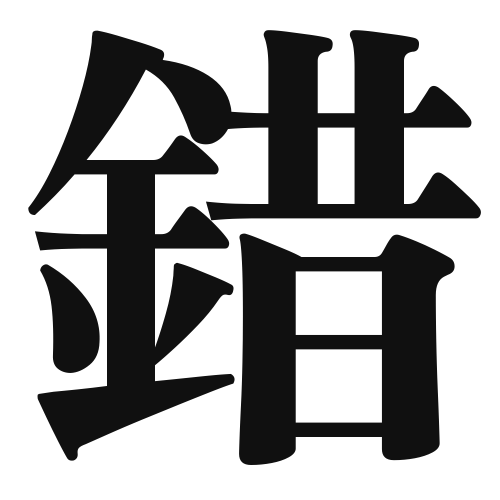1. Overview of Meaning
The kanji “錯” (saku) generally means “to confuse” or “to mix up.” It conveys the idea of something being in a state of disorder or misunderstanding.
2. Formation and Radical
Formation of the Kanji: The kanji “錯” is a compound character, which means it is formed by combining different elements. It is classified as a compound ideograph (会意文字), where the components contribute to the overall meaning.
Radical: The radical of “錯” is “石” (ishi), which means “stone.” This radical often relates to hardness or solidity, but in this context, it contributes to the overall meaning of confusion or mixing.
3. Examples of Usage
Common Words and Phrases: Some frequently used words that include “錯” are:
- 錯誤 (saku go) – mistake, error
- 錯覚 (saku kaku) – illusion, misperception
Example Sentences in Daily Conversation:
- 彼はその情報を錯誤してしまった。
(Kare wa sono jōhō o saku go shite shimatta.)
– He made a mistake with that information. - その映画は錯覚を引き起こす。
(Sono eiga wa saku kaku o hikiokosu.)
– That movie creates an illusion.
4. Synonyms and Antonyms
Similar Kanji: A similar kanji is “混” (kon), which means “to mix.” While both kanji convey a sense of mixing, “錯” emphasizes confusion or disorder, whereas “混” focuses more on the act of mixing itself.
Opposite Kanji: An antonym for “錯” is “明” (mei), which means “clear” or “bright.” This kanji represents clarity and understanding, contrasting with the confusion implied by “錯.”
5. Cultural and Historical Background
Relation to Japanese Culture: The concept of confusion and misunderstanding is prevalent in Japanese culture, often reflected in literature and art. The kanji “錯” can be found in various contexts, highlighting the importance of clarity in communication.
Proverbs and Idioms: One relevant proverb is “錯覚は真実の敵” (saku kaku wa shinjitsu no teki), which translates to “Illusions are the enemies of truth.” This emphasizes the idea that confusion can hinder one’s understanding of reality.
